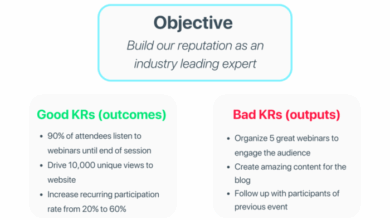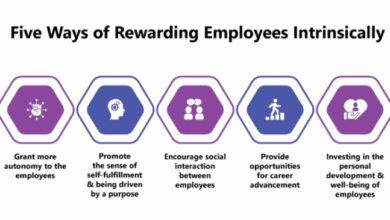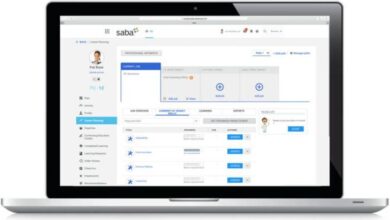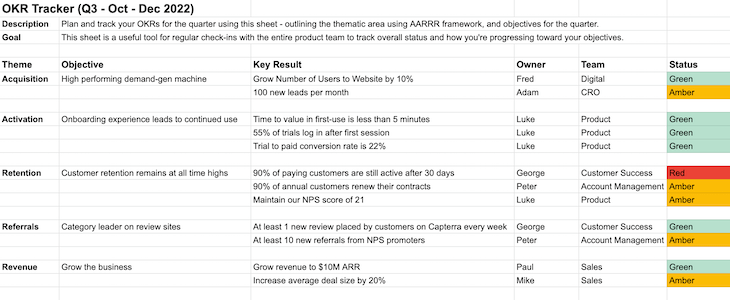
How to write OKRs sets the stage for achieving ambitious goals. This in-depth guide dives into the intricacies of crafting effective Objectives and Key Results (OKRs), offering actionable strategies and real-world examples to boost your performance and strategic alignment.
From defining clear objectives to setting measurable key results, and managing timelines effectively, this guide provides a roadmap for creating and implementing successful OKRs. We’ll cover everything from the foundational principles to advanced strategies for monitoring progress, adapting to change, and reviewing your OKRs for maximum impact.
Defining Objectives and Key Results (OKRs)
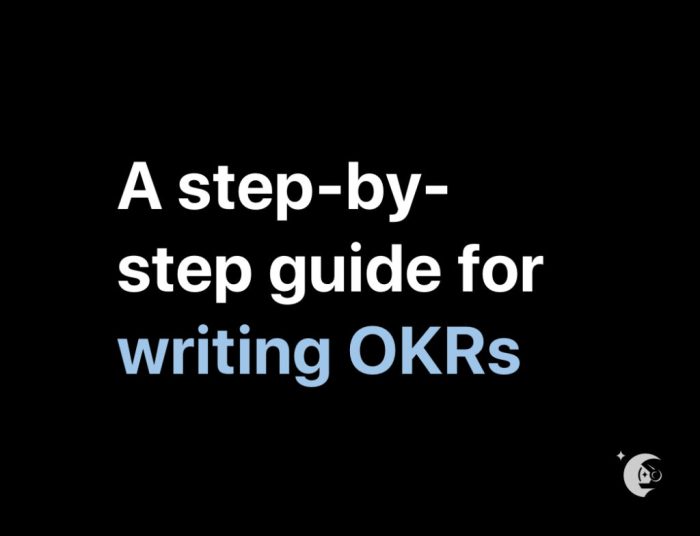
OKRs, or Objectives and Key Results, are a goal-setting framework widely used in organizations to define ambitious, measurable targets. They provide a structured approach to aligning teams and individuals towards shared, impactful outcomes. OKRs are more than just goals; they foster a culture of continuous improvement and provide a clear roadmap for achieving significant progress.Effective OKRs are designed to be aspirational yet attainable, focusing on measurable progress and driving tangible results.
They encourage collaboration and provide a common language for teams to discuss and track their progress. They also promote transparency and accountability, fostering a culture of learning and growth.
Defining Objectives
Objectives are the overarching, qualitative statements of what a team or individual intends to achieve. They provide a high-level direction and should be ambitious but attainable. Good objectives are concise, inspirational, and aligned with the overall strategic direction of the organization.
Figuring out how to write effective OKRs is crucial for any business, big or small. But with the rising costs of cybercrime, as detailed in this recent article about big businesses walloped with climbing cybercrime costs , it’s even more important to have a solid plan. Strong OKRs will help companies stay ahead of the curve and prioritize resources effectively, even amidst increasing security threats.
So, how do you craft compelling OKRs that truly drive results?
- Objectives should be ambitious, challenging, and motivating.
- They should be clearly defined, avoiding ambiguity or vagueness.
- Objectives should be aligned with the company’s overall strategic goals.
- They should be inspiring and provide a sense of purpose.
Defining Key Results
Key Results (KRs) are specific, measurable metrics that demonstrate progress towards achieving an objective. They translate the objective into quantifiable actions, enabling teams to track progress and identify areas for improvement. Well-defined KRs are essential for evaluating success and ensuring that objectives are not just theoretical aspirations.
- Key Results should be directly tied to the objective.
- They should be measurable and quantifiable, using specific metrics.
- They should have clear targets and deadlines.
- KRs should be realistic and attainable, but challenging enough to drive significant progress.
Examples of Well-Defined Objectives and Key Results
Objective: Increase website traffic by attracting new users.Key Results:
- Increase unique visitors by 20% in the next quarter.
- Generate 10,000 new leads through targeted marketing campaigns.
- Improve website ranking for key search terms by 15%.
Objective: Enhance customer satisfaction.Key Results:
- Achieve a 95% customer satisfaction rating based on surveys.
- Reduce customer support tickets by 10%.
- Increase customer retention rate by 5%.
Goals, Objectives, and Key Results
Goals are broad statements of intent, encompassing a range of potential outcomes. Objectives narrow these goals down to specific areas of focus. Key Results translate these objectives into tangible metrics that demonstrate progress. For instance, a goal might be “Improve customer experience,” an objective could be “Increase customer satisfaction ratings,” and a key result might be “Achieve a 90% customer satisfaction rating.”
Comparison of OKR Methodologies
| Methodology | Focus | Key Characteristics |
|---|---|---|
| Agile OKRs | Adaptability and flexibility | Iterative approach, frequent reviews, and adjustments to objectives and key results. |
| Traditional OKRs | Strategic alignment | Focus on long-term goals, detailed planning, and rigorous tracking. |
| Hybrid OKRs | Balance of adaptability and strategy | Combine elements of both agile and traditional approaches, allowing for flexibility while maintaining strategic alignment. |
This table presents a concise overview of various OKR methodologies, highlighting their distinct characteristics and focuses.
Crafting Effective Objectives
Objectives are the ambitious, aspirational goals that guide your team’s efforts within a given time frame. They represent the “why” behind your Key Results. A well-crafted objective inspires your team to strive for something meaningful and motivates them to achieve specific, measurable outcomes. It’s not just about what you want to accomplish; it’s about articulating the desired impact and direction of your work.Effective objectives are clear, concise, and focused.
They avoid ambiguity and leave no room for misinterpretation. They set the stage for your team’s journey and act as a compass for the entire OKR process. By creating compelling objectives, you ensure your team is working towards a shared understanding and common vision.
Designing Compelling Objectives
Objectives should be more than just a list of tasks. They should represent a significant shift or impact within your team’s domain. Think of them as a North Star guiding your work. They should be inspirational and motivational, encouraging your team to work collaboratively and creatively. A compelling objective evokes a sense of purpose and excitement, setting the stage for tangible results.
Measurable Objectives
Objectives should be tied to measurable outcomes. This allows you to track progress and identify areas where adjustments might be necessary. Instead of stating “increase sales,” a measurable objective might be “Increase sales by 15% in Q3 compared to Q2.” This quantifiable goal provides a clear benchmark for success. Here are some examples:
- Increase website traffic by 20% within the next quarter.
- Reduce customer support tickets by 10% in the next quarter.
- Improve product satisfaction ratings by 2 points within the next quarter.
These examples clearly define the desired outcome and the metrics used to measure success.
Connecting Objectives to Strategic Goals
Each objective should directly contribute to your overall strategic goals. This ensures alignment and a unified focus across all teams and projects. A well-defined objective will clearly demonstrate its contribution to the larger company strategy. For instance, if your strategic goal is to increase market share, an objective might be “Increase market share in the North American region by 5% by the end of the year.”
Ensuring Ambitious Yet Attainable Objectives
Ambitious objectives are vital for driving significant progress. However, they must also be attainable within the given timeframe and resources. It’s a delicate balance between stretching the team and maintaining realistic expectations. Setting an objective that’s too ambitious can demotivate the team, while one that’s too easy may not yield the desired results.
Common Pitfalls in Objective Creation
| Pitfall | How to Avoid |
|---|---|
| Vague or Unclear Objectives | Be specific and concise. Use quantifiable language and define specific metrics for measuring success. |
| Objectives Too Broad | Break down overarching goals into smaller, more manageable objectives. |
| Objectives Not Tied to Strategic Goals | Clearly articulate how the objective contributes to the overall company strategy. |
| Objectives Too Easy or Unchallenging | Set objectives that require effort and commitment while remaining achievable within the given timeframe. |
| Objectives Not Measurable | Define clear metrics and benchmarks for measuring progress towards the objective. |
By understanding and proactively addressing these pitfalls, you can set up your team for success with well-defined and impactful objectives.
Defining Key Results
Defining Key Results is a crucial step in the OKR process. Effective Key Results are the quantifiable measures that demonstrate progress toward achieving the objective. They provide a clear roadmap for tracking success and identifying areas needing adjustment. These measurable outcomes are vital for understanding the impact of your efforts and ensuring alignment with your overall strategic goals.
Characteristics of Effective Key Results
Effective Key Results possess several key characteristics. They are specific, measurable, achievable, relevant, and time-bound (SMART). This ensures clarity and focus, enabling teams to track progress effectively. Moreover, they directly contribute to the objective’s achievement. Ambiguity in Key Results can lead to misalignment and wasted effort.
Quantifiable Key Results Examples
Key Results must be quantifiable. This allows for clear progress tracking. Here are some examples:
- Increase website traffic by 20% in Q3 2024.
- Reduce customer support tickets by 15% in the next quarter.
- Launch 3 new product features by the end of Q4 2024.
- Improve customer satisfaction scores by 10 points.
These examples illustrate the concrete and measurable nature of effective Key Results.
Alignment with Objectives
Key Results must directly support the objective. They should answer the question: “How will we know we’ve achieved the objective?” If a Key Result doesn’t contribute to the objective, it’s likely misaligned and should be revisited. A strong connection ensures that efforts are focused on achieving the desired outcome.
Measuring Progress Towards Key Results
Regular monitoring and reporting are crucial for measuring progress toward Key Results. This includes setting milestones, tracking data, and analyzing trends. Tracking metrics and analyzing data provide valuable insights for making necessary adjustments and ensuring progress toward achieving the objective. Tools like spreadsheets or project management software can help in this process.
Different Types of Key Results and Metrics
The table below illustrates various types of Key Results and their corresponding metrics.
| Key Result Type | Metric | Example |
|---|---|---|
| Increased Engagement | Number of interactions (e.g., likes, comments, shares) | Increase social media engagement by 15% |
| Improved Efficiency | Time spent on task, cycle time | Reduce the average time to resolve customer issues by 10% |
| Enhanced Quality | Defect rate, error rate, customer satisfaction score | Reduce product defect rate to below 1% |
| Market Penetration | Number of new customers acquired, market share | Increase customer acquisition by 20% in Q4 2024 |
This table demonstrates the diverse range of Key Results and the associated metrics used to measure progress.
Setting Timeframes and Deadlines
Defining clear timeframes and deadlines is crucial for the success of your OKRs. Without concrete timelines, your team may lose focus, deadlines may be missed, and the overall impact of your efforts diminished. Well-defined timeframes provide a structured approach to progress tracking, ensuring accountability and allowing for proactive adjustments as needed. Realistic deadlines foster a sense of urgency and promote efficient task management, maximizing the impact of your strategic goals.
Importance of Clear Timeframes
Timeframes are essential for several reasons. They provide a structured framework for planning and execution, enabling teams to prioritize tasks and allocate resources effectively. Clear timeframes facilitate better progress tracking and create a sense of urgency, motivating teams to stay on track. Without defined timeframes, teams can easily become bogged down in ongoing tasks, potentially leading to delays and missed opportunities.
This structured approach fosters accountability and allows for proactive adjustments.
Establishing Realistic Deadlines for Key Results
Establishing realistic deadlines is vital for the success of your OKRs. Overly ambitious deadlines can lead to frustration and burnout, while overly lax deadlines can result in procrastination and a lack of urgency. To establish realistic deadlines, consider the complexity of the tasks involved, the resources available, and any potential obstacles. Breaking down large, complex tasks into smaller, more manageable milestones can help create a more accurate timeline.
Understanding resource availability, both human and technological, is crucial. Factor in potential roadblocks or unforeseen challenges.
Examples of Timeframes and Their Implications
Different timeframes have varying implications for progress tracking. Short-term deadlines (e.g., weekly, monthly) are ideal for tasks requiring frequent check-ins and adjustments. Longer-term deadlines (e.g., quarterly, annually) are more suitable for projects with a longer development cycle. For example, a key result to “increase website traffic by 20%” might have a quarterly timeframe, whereas a key result to “launch a new product feature” might have a shorter timeframe, such as a month, to accommodate testing and refinement.
This ensures that progress is tracked effectively and adjusted promptly if necessary.
Writing effective OKRs requires a clear understanding of your goals and how to measure success. One key element is tying those goals to real-world impact, like the recent trend of “rim plays devs for dollars” here. Analyzing how companies are leveraging developer resources for financial gain can provide valuable insights when crafting your own OKRs, helping you focus on quantifiable results.
Ultimately, understanding market dynamics is crucial to writing impactful OKRs.
Managing Multiple OKRs with Overlapping Deadlines
Managing multiple OKRs with overlapping deadlines requires careful planning and prioritization. A project management tool or calendar can be incredibly helpful in visualizing overlapping deadlines and identifying potential conflicts. Prioritize OKRs based on their importance and urgency. Clearly define dependencies between OKRs, if any exist, and allocate resources accordingly. For example, if two OKRs rely on the same team member, ensure that their workload is manageable.
By proactively managing potential conflicts, you can ensure that all OKRs stay on track.
Incorporating Flexibility into OKR Timelines
Incorporating flexibility into OKR timelines is crucial for accommodating unexpected challenges or opportunities. While a firm timeline is important, build in buffer periods or contingency plans. These buffers can help absorb unforeseen delays or allow for adjustments as needed. For instance, if a critical component of a key result is delayed, having a buffer period can prevent the entire OKR from being affected.
This adaptability allows you to maintain progress while still remaining responsive to evolving circumstances. Anticipate potential challenges and incorporate contingency plans into your timelines.
Monitoring and Tracking Progress
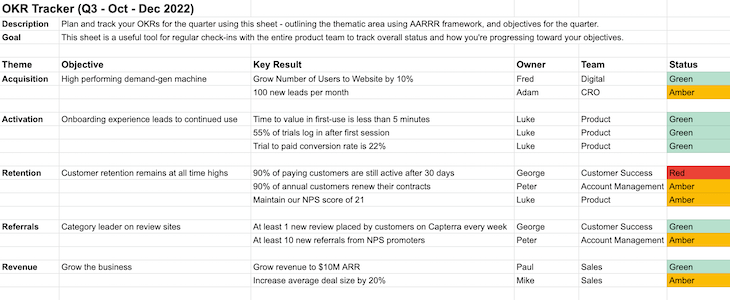
OKRs are living documents, not static goals. Successfully achieving them requires consistent monitoring and adaptation. This involves more than just checking boxes; it’s about understanding the nuances of progress, identifying potential roadblocks, and proactively adjusting your approach. This crucial phase allows you to refine your strategy, ensuring alignment with your overall objectives.Effective OKR monitoring is not about just gathering data; it’s about using that data to make informed decisions.
Regular review meetings, detailed reporting, and proactive problem-solving are all essential components of this process. This allows you to remain agile and responsive to changes in the market or within your team.
Methods for Tracking Progress Towards Key Results
Regular progress reviews are essential for staying on track. These meetings provide a platform for open communication, enabling teams to discuss challenges, celebrate milestones, and reallocate resources as needed. Frequency should be determined based on the complexity of the key results and the nature of the project. Weekly or bi-weekly reviews are common for more complex projects.
- Data Collection: Establish clear metrics for each key result. This could include quantitative data (e.g., number of sales, website traffic) or qualitative data (e.g., customer satisfaction scores, team feedback). Consistent data collection ensures you have a reliable baseline for measuring progress.
- Visualizations: Charts and graphs are invaluable tools for visualizing progress. Bar charts, line graphs, and progress circles can clearly illustrate the trend of key results over time. This visual representation makes it easier to spot patterns and identify areas needing attention.
- Regular Reporting: Establish a reporting cadence. This could be daily, weekly, or monthly, depending on the project. Clear and concise reports that highlight progress against key results are crucial for keeping stakeholders informed. Include relevant data, observations, and any identified roadblocks.
Examples of Relevant Dashboards and Reporting Tools
Dashboards provide a centralized view of key performance indicators (KPIs). They should be tailored to the specific needs of the team and project. There are numerous tools available, both free and paid, that can help create effective dashboards. Examples include Google Data Studio, Tableau, and Power BI.
- Google Data Studio: A powerful, free tool that allows users to create interactive dashboards using data from various sources. It offers a wide range of visualization options.
- Tableau: A popular data visualization tool, known for its flexibility and advanced analytics capabilities. It’s suitable for projects requiring sophisticated data analysis and reporting.
- Power BI: Microsoft’s business intelligence tool that provides a comprehensive suite of features for data analysis and visualization. It seamlessly integrates with other Microsoft products.
Identifying and Addressing Potential Roadblocks to Progress
Proactive identification and mitigation of potential roadblocks is crucial for successful OKR implementation. Regular reviews provide opportunities to anticipate and address issues before they escalate.
- Regular check-ins: Encourage team members to identify potential roadblocks early on. Open communication and feedback mechanisms are vital for early issue detection. Encourage team members to identify potential roadblocks proactively.
- Problem-solving meetings: Dedicated meetings to address identified roadblocks are essential. These meetings should focus on brainstorming solutions and developing action plans. Engage all relevant parties in these problem-solving meetings to ensure a holistic approach.
- Flexibility and Adaptability: Be prepared to adjust your approach based on emerging challenges. OKRs should be living documents, adaptable to changing circumstances. Be willing to pivot your strategy when necessary.
Methods for Adapting OKRs Based on Changing Circumstances
Adapting OKRs is a crucial aspect of maintaining alignment with evolving priorities. The ability to adjust your strategy is essential for responding to unexpected changes.
- Regular review meetings: Regular review meetings allow for assessment of the current situation and reevaluation of progress. This enables teams to adapt OKRs based on new information or emerging challenges.
- Flexibility and Communication: Establish clear communication channels for discussing changes and adjustments to OKRs. This ensures that all stakeholders are aware of any necessary modifications.
- Collaboration: Encourage collaboration between team members and stakeholders to ensure that changes are supported and implemented effectively.
Examples of Progress Reports and Data Visualizations for OKRs
Data visualization plays a crucial role in understanding OKR progress. Progress reports should be clear, concise, and easy to understand.
- Example 1: A line graph illustrating the weekly progress toward a key result of increasing website traffic. The graph visually displays the trend over time, allowing stakeholders to identify any fluctuations or potential issues.
- Example 2: A bar chart showing the progress of multiple key results across different departments. This visual comparison allows for a high-level understanding of performance and potential areas for improvement.
Reviewing and Iterating on OKRs
OKRs aren’t set and forgotten. Regular review and iteration are crucial for maintaining alignment, adapting to changing circumstances, and maximizing the impact of your objectives. By consistently evaluating progress and gathering feedback, teams can refine their approach and ensure they’re on the right track to achieve their goals. This dynamic process allows for adjustments based on emerging data, leading to a more efficient and effective strategy.Effective review cycles are integral to the OKR process, allowing teams to identify areas for improvement, celebrate successes, and learn from setbacks.
This iterative approach keeps the focus sharp and ensures the objectives remain relevant and attainable throughout the defined timeframe.
Importance of Regular Reviews and Feedback, How to write okrs
Regular reviews are essential for gauging the effectiveness of your OKRs. Feedback, both positive and constructive, helps teams identify what’s working well and where adjustments are needed. This iterative approach keeps the team engaged and ensures the objectives remain relevant to the evolving needs and priorities of the organization. Gathering feedback early and often allows for course correction before significant delays or setbacks occur.
Examples of Effective Review Processes
A variety of review processes can be effective. Some teams find weekly check-ins most beneficial, allowing for timely adjustments. Others prefer a more structured monthly review, providing a comprehensive overview of progress. The key is to find a cadence that works for your team and the complexity of the objectives. These reviews should incorporate a thorough analysis of progress toward key results, a discussion of any roadblocks, and an assessment of any required changes to the strategy.
Strategies for Adapting OKRs Based on Feedback and Performance Data
Adapting OKRs based on feedback and performance data is a vital component of the process. If a key result isn’t on track, the team should proactively identify the reasons why and develop a revised strategy. This might involve adjusting the timeline, redefining the key result, or even altering the objective itself. If a key result is exceeding expectations, the team can explore ways to leverage that success and potentially expand the scope of the objective or adjust the key results to reflect the increased capacity.
It’s crucial to document these changes and the rationale behind them to maintain transparency and accountability.
Significance of Celebrating Successes and Learning from Setbacks
Acknowledging and celebrating successes is vital for maintaining team morale and reinforcing positive behaviors. Recognizing milestones, even small ones, keeps the team motivated and focused on the positive impact of their work. Likewise, setbacks provide invaluable learning opportunities. Analyzing what went wrong, identifying the root causes, and implementing corrective measures fosters a culture of continuous improvement. This cyclical process ensures that lessons learned are applied to future projects, leading to enhanced performance over time.
OKR Review Meeting Formats
| Meeting Format | Advantages |
|---|---|
| Short Weekly Check-ins (15-30 minutes) | Agile adjustments, early problem identification, high team engagement |
| Monthly Progress Reviews (1-2 hours) | Comprehensive review, strategic alignment, identification of long-term trends |
| Quarterly Performance Reviews (3-4 hours) | Deep dive into overall progress, adjustments to long-term strategy, alignment with organizational goals |
These formats offer different levels of detail and focus. The choice of format should be tailored to the specific needs and context of the team and the objectives being reviewed.
OKR Examples Across Industries: How To Write Okrs
OKRs are a powerful tool for setting and achieving ambitious goals, but their effectiveness hinges on adapting them to specific industry contexts. This section dives into practical examples across various industries, demonstrating how OKRs can be tailored for optimal results. From boosting marketing campaigns to streamlining financial processes, we’ll see how OKRs can drive tangible improvements.OKR implementation is not a one-size-fits-all approach.
Understanding the unique dynamics of each industry is crucial for creating effective OKRs. By examining successful implementations, we can glean insights into adapting OKR templates for specific situations, leading to more impactful outcomes.
Tech Industry OKR Examples
Tech companies often prioritize innovation and rapid growth. A software development company might set an objective to “Launch a new mobile app” with key results like “Achieve 10,000 downloads within the first month” and “Receive a 4.5-star rating on app stores.” This example highlights the measurable nature of key results. Another example could be “Increase user engagement” with key results like “Boost daily active users by 20%,” and “Reduce app crash rates by 15%.” These focus on user experience and app stability.
Figuring out how to write effective OKRs can be tricky, but a solid framework is key. Understanding the intricacies of your virtualized data center, like those discussed in the nitty gritty of the virtualized data center , is crucial for aligning your OKRs with your infrastructure’s capabilities. Ultimately, a well-defined OKR strategy will empower your team to succeed, regardless of the complexity of the technical landscape.
Marketing OKR Examples
Marketing teams leverage OKRs to track campaign performance and brand awareness. A company focused on social media marketing might set an objective to “Increase brand awareness” with key results like “Grow social media followers by 15%,” and “Generate 200 qualified leads.” Another example could be “Drive website traffic” with key results like “Increase organic website traffic by 10%,” and “Achieve a 20% conversion rate.”
Finance Industry OKR Examples
Financial institutions utilize OKRs for efficiency and profitability. A bank might set an objective to “Enhance customer service” with key results like “Reduce customer complaint rates by 10%,” and “Increase customer satisfaction scores by 15%.” Another example could be “Increase investment portfolio returns” with key results like “Achieve a 12% return on investments,” and “Manage risk exposure within acceptable parameters.”
Adapting OKR Templates for Specific Industries
The success of OKRs relies on customization. A general OKR template should be adjusted to reflect specific industry dynamics. For example, a tech company focusing on rapid product development might prioritize short-term OKRs, while a financial institution might focus on long-term strategies. Consider industry benchmarks, competitive landscapes, and internal capabilities when tailoring OKRs.
OKR Implementation Across Company Sizes
| Company Size | OKR Implementation ||—|—|| Small Business | Focus on clarity, simplicity, and direct impact. Agile approach to adapt to changing market conditions. Frequent reviews and iterations are critical. || Medium-sized Business | OKRs should be aligned with departmental and overall company objectives. Establish clear communication channels to ensure alignment.
Regular reporting and feedback mechanisms are important. || Large Enterprise | OKRs need to cascade down through different departments and teams. Utilize data-driven insights to monitor progress and identify areas for improvement. A robust framework for communication and reporting is essential. |This table highlights the adaptability of OKRs across various company sizes.
The core principles remain consistent; clarity, alignment, and measurement are crucial.
Tools and Resources for OKR Management
OKRs are powerful, but their effectiveness hinges on the tools used to manage them. A well-chosen OKR management platform can streamline the process, enhance collaboration, and provide valuable insights into progress. This section delves into the world of OKR tools, exploring their features, benefits, and limitations to help you choose the right one for your team’s needs.Effective OKR management requires a platform that seamlessly integrates into your workflow.
Choosing the right tool can significantly impact team productivity and the overall success of your OKRs. Consider factors like ease of use, collaboration features, reporting capabilities, and scalability when evaluating potential platforms.
Popular OKR Management Tools
Various tools cater to different needs and budgets. Some are specifically designed for OKR management, while others are more general project management platforms that can support OKRs. Popular choices include Asana, Monday.com, ClickUp, and dedicated OKR platforms like Objectives and OKRs. Understanding the features of each is key to selecting the right fit.
Comparative Analysis of Tools
A comparative analysis highlights the strengths and weaknesses of different tools. Consider factors like pricing models, features (e.g., goal setting, progress tracking, reporting), user interface, integrations with existing systems, and support for different team sizes. A robust tool should seamlessly integrate with your existing project management software.
- Asana: Asana is a versatile project management tool that can be adapted to support OKR management. Its strengths lie in its intuitive interface and task management features. However, its dedicated OKR functionalities might not be as comprehensive as specialized platforms.
- Monday.com: Monday.com provides a highly customizable platform. Its drag-and-drop interface allows for flexible organization and visualization of OKRs, making it suitable for complex projects and diverse team structures. However, its comprehensive OKR features might not be as intuitive as those of specialized tools.
- ClickUp: ClickUp, with its robust task management capabilities, also offers OKR support. Its versatility and detailed task breakdowns make it suitable for teams with intricate workflows. However, it may require more setup time for complex OKR implementations compared to dedicated platforms.
- Objectives and OKRs: Dedicated OKR platforms like Objectives and OKRs provide specialized tools designed specifically for OKR management. These tools often offer more sophisticated features, such as advanced reporting, collaborative dashboards, and goal-setting templates. They are frequently more expensive than general project management platforms.
Benefits and Limitations of Different Tools
The benefits and limitations of each tool are crucial for informed decision-making. Consider the specific needs of your team and the resources available when evaluating the options.
- Asana: Asana’s strength lies in its familiarity and ease of use for teams already using it. Its limitations might stem from a less focused approach to OKR management compared to dedicated platforms.
- Monday.com: Monday.com’s customizable nature allows for extensive integration, but its comprehensive OKR features might not be as readily accessible as dedicated tools.
- ClickUp: ClickUp’s versatility can be both a benefit and a limitation. Its complex features might be overwhelming for teams unfamiliar with project management software.
- Objectives and OKRs: Dedicated OKR platforms offer sophisticated functionalities, but their cost can be a significant factor.
Choosing the Right Tool for Specific Needs
Choosing the correct tool hinges on careful evaluation of your team’s size, complexity of projects, budget, and existing workflows. Consider whether a general project management tool or a specialized OKR platform is better suited for your needs.
- Team Size and Structure: Smaller teams might benefit from a general project management tool with OKR support, while larger teams might need a dedicated platform to manage complex objectives.
- Project Complexity: Projects with intricate dependencies and multiple stakeholders might require a highly customizable platform.
- Budget Constraints: Dedicated OKR platforms typically have higher pricing models than general project management tools.
- Existing Workflow: Integrating the chosen tool into your existing workflow is critical for efficient OKR management.
Examples of User Interfaces and Functionalities
Different platforms have unique user interfaces and functionalities. The interface should be intuitive and easy to navigate. Look for platforms with clear progress visualizations and collaborative features. Examples of functions include progress bars, real-time collaboration features, and automated reports.
End of Discussion
In conclusion, mastering the art of writing OKRs is a crucial step towards achieving your strategic goals. This comprehensive guide has provided a clear framework, practical examples, and actionable steps to help you craft effective OKRs that drive progress and enhance performance. Remember to continuously monitor, adapt, and review your OKRs to ensure they remain aligned with your evolving objectives.
This dynamic approach to goal-setting will empower you to navigate complexities and achieve exceptional results.



